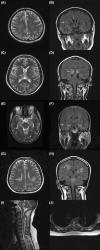Study on clinical features and factors related to long-term outcomes of antibody-negative autoimmune encephalitis
- PMID: 38644648
- PMCID: PMC11093238
- DOI: 10.1002/acn3.52049
Study on clinical features and factors related to long-term outcomes of antibody-negative autoimmune encephalitis
Abstract
Objective: To delineate the clinical characteristics of antibody-negative autoimmune encephalitis (AE) and to investigate factors associated with long-term outcomes among antibody-negative AE.
Methods: Patients diagnosed with antibody-negative AE were recruited from January 2016 to December 2022 at the Second Xiangya Hospital of Central South University. The study assessed the long-term outcomes of antibody-negative AE using the modified Rankin scale (mRS) and the Clinical Assessment Scale in Autoimmune Encephalitis (CASE). Predictors influencing long-term outcomes were subsequently analyzed. External validation of RAPID scores (refractory status epilepticus [RSE], age of onset ≥60 years, ANPRA [antibody-negative probable autoimmune encephalitis], infratentorial involvement, and delay of immunotherapy ≥1 month) was performed.
Results: In total, 100 (47 females and 53 males) antibody-negative AE patients were enrolled in this study, with approximately 49 (49%) experiencing unfavorable long-term outcomes (mRS scores ≥3). Antibody-negative AE was subcategorized into ANPRA, autoimmune limbic encephalitis (LE), and acute disseminated encephalomyelitis (ADEM). Psychiatric symptoms were prevalent in LE and ANPRA subtypes, while weakness and gait instability/dystonia were predominant in the ADEM subtype. Higher peak CASE scores (odds ratio [OR] 1.846, 95% confidence interval [CI]: 1.163-2.930, p = 0.009) and initiating immunotherapy within 30 days (OR 0.210, 95% CI: 0.046-0.948, p = 0.042) were correlated with long-term outcomes. Receiver operating characteristic (ROC) analysis returned that the RAPID scores cutoff of 1.5 best discriminated the group with poor long-term outcomes (sensitivity 85.7%, specificity 56.9%).
Interpretation: The ANPRA subtype exhibited poorer long-term outcomes compared to LE and ADEM subtypes, and early immunotherapy was crucial for improving long-term outcomes in antibody-negative AE. The use of RAPID scoring could aid in guiding clinical decision making.
© 2024 The Authors. Annals of Clinical and Translational Neurology published by Wiley Periodicals LLC on behalf of American Neurological Association.
Conflict of interest statement
The authors declare that they have no conflict of interest.
Figures





References
MeSH terms
Grants and funding
LinkOut - more resources
Full Text Sources
Medical
